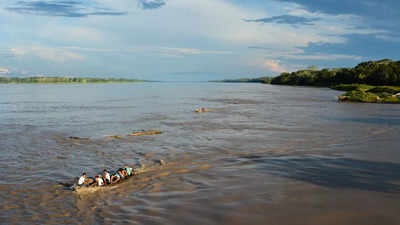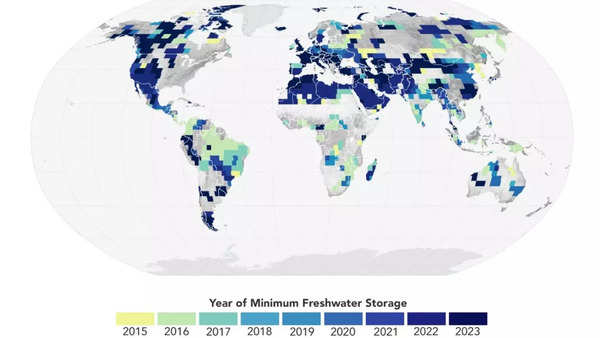NASA-German satellites reveal alarming 290 cubic miles loss in Earth’s freshwater resources since 2014
A groundbreaking study using data from NASA and German satellites has uncovered a dramatic decline in Earth’s freshwater resources since 2014. Published in Surveys in Geophysics, this research warns that the planet is entering an extended dry period, posing serious risks to global water security.
From 2015 to 2023, the average amount of freshwater stored on land—including surface water like lakes and rivers, as well as groundwater in aquifers—was 290 cubic miles (1,200 cubic km) lower than levels observed between 2002 and 2014. This loss, equivalent to two and a half times the volume of Lake Erie, marks an alarming trend of water depletion.
Researchers attribute this to climate change, extreme weather events, and an increased reliance on groundwater, creating a cycle of depletion that could have severe consequences for agriculture, communities, and global water resources.
NASA-German satellites discover shocking decline in freshwater resources
The study utilised data from NASA-German satellites uncovering a dramatic decline in Earth’s freshwater resources since May 2014. The research reveals that between 2015 and 2023, the average amount of freshwater stored on land—combining surface water like lakes and rivers, as well as groundwater in aquifers—was 290 cubic miles (1,200 cubic km) lower than between 2002 and 2014.
Matthew Rodell, a hydrologist at NASA’s Goddard Space Flight Center and co-author of the study, compared the loss to two and a half times the volume of Lake Erie, highlighting significant risks to global water security.
The cycle of groundwater depletion: How does it work
During droughts, combined with the global expansion of irrigated agriculture, farms and cities have increasingly relied on groundwater, leading to a cycle of dwindling underground water supplies. Freshwater stores become depleted, rainfall fails to replenish them, and more groundwater is pumped, exacerbating the problem.
This depletion places significant pressure on farmers and communities, potentially leading to famine, conflicts, poverty, and an increased risk of disease from contaminated water sources, according to a 2024 UN report on water stress.
Tracking freshwater loss with GRACE satellites
The team of researchers identified this global decrease in freshwater using data from the Gravity Recovery and Climate Experiment (GRACE) satellites, operated by NASA, the German Aerospace Center, and the German Research Centre for Geosciences.
GRACE satellites measure fluctuations in Earth’s gravity to detect changes in water mass both on and beneath the surface. The original
GRACE satellites
operated from March 2002 to October 2017, while the successor GRACE–Follow On (GRACE–FO) satellites launched in May 2018.
A map included in the study highlights the regions where freshwater levels hit their lowest points over the past 22 years, with darker areas indicating more recent water loss. This map shows that a large portion of the global land surface reached its driest point between 2015 and 2023—the nine warmest years in modern temperature records.
Image source: NASA
The role of El Niño and global warming
The decline began with a severe drought in northern and central Brazil, followed by major droughts across Australasia, South America, North America, Europe, and Africa. Researchers attribute these droughts in part to warmer ocean temperatures in the tropical Pacific from late 2014 to 2016, which led to one of the most significant El Niño events since 1950.
This, in turn, caused shifts in atmospheric jet streams, altering global weather and rainfall patterns. However, even after El Niño subsided, global freshwater levels continued to decline. In fact, 13 of the world’s 30 most intense droughts observed by
GRACE
occurred since January 2015. Rodell and his team believe that global warming is likely contributing to the ongoing depletion of freshwater resources.
The impact of extreme precipitation and droughts on freshwater availability
Rising global temperatures increase the atmosphere’s capacity to hold more water vapour, which leads to more extreme precipitation events, according to NASA meteorologist Michael Bosilovich.
While total annual rainfall may not change dramatically, longer dry periods between intense precipitation events prevent the soil from absorbing water effectively, reducing groundwater replenishment. The problem with extreme precipitation is that much of the water runs off the land, rather than being absorbed into the ground.
Since the 2014-2016 El Niño, freshwater levels globally have remained consistently low, with more water trapped in the atmosphere as vapour. Warming temperatures not only increase evaporation from the surface but also intensify drought conditions, further stressing freshwater resources.
Uncertain future for freshwater resources
Although there is a strong suspicion that global warming is a key driver of this abrupt drop in freshwater levels, linking the two with certainty remains challenging, noted Susanna Werth, a hydrologist and remote sensing scientist at Virginia Tech, who was not involved in the study. “There are uncertainties in climate predictions,” Werth explained, “and measurements and models always come with errors.”
The future of global freshwater availability remains uncertain. It is yet to be seen whether freshwater levels will recover to pre-2015 levels, stabilise, or continue to decline. Given that the nine warmest years in modern history align with this significant freshwater loss, Rodell emphasised, “We don’t think this is a coincidence, and it could be a harbinger of what’s to come.”
Also Read | Hubble Space Telescope: A glimpse into the latest stunning space images
I’m Manas Ranjan Sahoo: Founder of “Webtirety Software”. I’m a Full-time Software Professional and an aspiring entrepreneur, dedicated to growing this platform as large as possible. I love to Write Blogs on Software, Mobile applications, Web Technology, eCommerce, SEO, and about My experience with Life.








